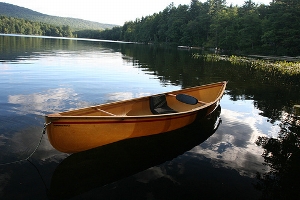In the world of Adirondack paddling few boats are as iconic as the Adirondack Guideboat; however, the boat of choice has almost always been the simple canoe. Long before European settlers reached the New World the Iroquois people were utilizing both dugout and birch bark style canoes which were both of tough construction. When the natives were driven from their lands the settlers developed the Adirondack Guideboat which was a hybrid between a native canoe and a row boat. The reign of the guideboat lasted about 60 years from 1850-1910 before the canoe once again became popular for its toughness and ease of use. These traits made it a perfect fit for the hordes of visitors flocking to the park who lacked the skill required by the guideboat (Terrie, 136).
When the natives were driven from their lands the settlers developed the Adirondack Guideboat which was a hybrid between a native canoe and a row boat. The reign of the guideboat lasted about 60 years from 1850-1910 before the canoe once again became popular for its toughness and ease of use. These traits made it a perfect fit for the hordes of visitors flocking to the park who lacked the skill required by the guideboat (Terrie, 136).
The canoe has undergone many changes since its popularity boomed in the early 20th century, usually involving newer materials and lighter designs. Some designers within the park have taken the canoe to the extremes of lightness and durability. Hornbeck Boats has been building single person canoes for over 40 years in the park. Their extremely light weight and maneuverability make them perfect for carrying between waters and into some of the smaller ponds hidden in the Adirondacks (Hornbeck Boats). Another notable builder is John Berry who specializes in white water canoes and kayaks. He began making his boats in 1959 in the earliest days of the sport and won 6 national championships in his own designs (Smith 1979).
The Adirondacks are perfect for white water paddling because of the long melting season and high gradient (steep) rivers which flow through the park. The rivers are what drew visionary builders like John Berry to the region, and they also drove the innovation and evolution of the sport. While the sporting part of whitewater paddling is relatively new, the act of running rapids and whitewater go as far back as the first canoes built by man. In his book, Adventures in the Wilderness, the Reverend William H. H. Murray describes his excitement at canoeing whitewater in the Adirondacks, proving that people enjoyed the sport long before it became organized (Murray, 78). For more information on whitewater paddling click here.
While the sporting part of whitewater paddling is relatively new, the act of running rapids and whitewater go as far back as the first canoes built by man. In his book, Adventures in the Wilderness, the Reverend William H. H. Murray describes his excitement at canoeing whitewater in the Adirondacks, proving that people enjoyed the sport long before it became organized (Murray, 78). For more information on whitewater paddling click here.
Paddling in the park can be whatever you want to make it. There are enough lakes, ponds, and rivers in the park that you could paddle for the rest of your life and never truly become familiar with all that the park has to offer. One thing to keep in mind is that the reason there are so many different types of canoes and kayaks is because they are each suited to a particular type of water and user (Roberts 1979). Getting the advice of an expert will help make your paddling experience in the Adirondacks the most enjoyable one possible. For more information on paddling in the park click here.
Works Cited
Murray, W. H. H. Adventures in the Wilderness. Syracuse, N.Y.: Adirondack Museum, 1970.
Roberts, Harry. “Picking Your Boat.” Adirondack Life V10 (1979): 20-24
Smith, Mason. “White Water Man.” Adirondack Life V10 (1979): 38-41
Terrie, Philip G. Contested Terrain a New History of Nature and People in the Adirondacks. Blue Mountain Lake, N.Y.: Adirondack Museum ;, 1999. 136-137. Print.
"Ultra Light Custom Canoe Made in the Adirondack Mountains." Ultra Light Custom Canoe Made in the Adirondack Mountains. Accessed April 5, 2015.
